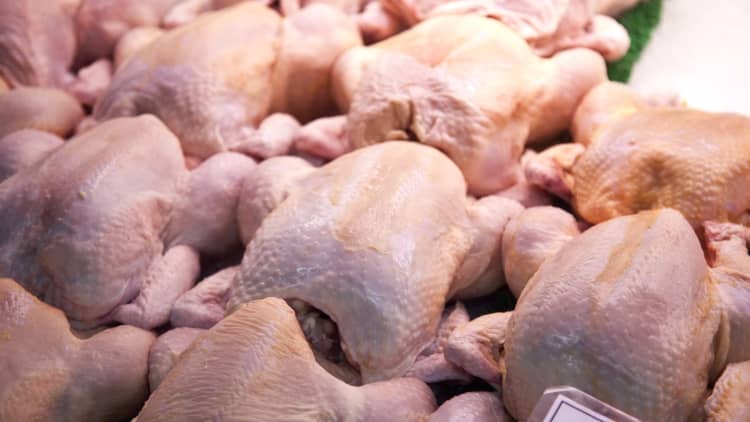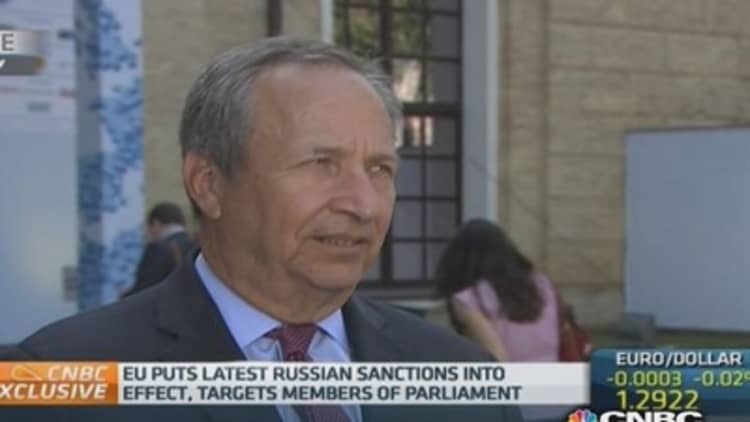A decree signed by Russian President Vladimir Putin to ban imports on U.S. poultry is leaving folks hungry—just not the ones he intended.
Putin's move in early August to block American chickens has backfired, sources in the poultry industry say, leaving Russians to pay more at the supermarket for poultry products while American producers remain largely unscathed. The Kremlin put agricultural sanctions in place against several Western nations in retaliation for penalties from the U.S. and European Union following Russia's invasion of Ukraine.
"The real loser is the average Russian consumer, who is now faced with less choices and increased prices for poultry," said Tom Super, a spokesman for the National Chicken Council. Poultry prices in Russia have risen about 2-3 percent each week since the ban, according to Super.
Read MoreUkraine: A struggle between hard and soft power
Russian consumer inflation is higher generally. The country's central bank governor, Elvira Nabiullina, that inflation could exceed 7.5 percent this year "and may be even higher." The central bank has directly implicated sanctions against food imports for that rise.
Russia's economy has also taken a hit from the falling price of oil, which accounts for about half of the Russian government's revenue, and the fact that Moscow is absorbing new costs related to Crimea, which it invaded and annexed this year.

Cheaper chicken in US? Don't count on it
All that said, the sudden halt of American chicken exports to Russia has not resulted in greater supply—and lower prices—in the United States, either.
Prices for chicken leg quarters, the main poultry product the U.S. typically ships to Russia, are only marginally lower. For the week ending Sept. 25, the price of a tray pack of leg quarters was $1.15, about 15 cents cheaper than the week before. But this week's prices are still 8 cents higher than this time last year.
"Bottom line is that U.S. consumers won't see much of a difference at the checkout line due to the Russian ban on chicken leg quarters," Super said.
The failure of Russian sanctions to affect prices or hurt U.S. producers is actually typical of such measures, political scientists say. Sanctions have a tendency to fail to affect prices for producers in the long term because they adjust to them.
"The issue with sanctions is that once they're imposed, firms adjust," said Bryan Early, a professor of political science at the University of Albany. "Producers who weren't expecting the sanctions are going to have an over-supply. They're probably going to have to drop their prices in the short run, but in the longer run, they'll adjust" their output.
Read MorePutin wants to control Russian web access: Reports
The Russian market is worth about $300 million for U.S. poultry producers, and chicken represents the largest share of U.S. agriculture exports to Russia. But it's not as important for U.S. poultry producers as it once was.
The United States exports only 20 percent of the poultry it produces. And while at one time Russia constituted as much as 40 percent of poultry exports, in 2013 the U.S. shipped only 7 percent of exports there, according to James Sumner, president of the USA Poultry and Egg Export Council. Sumner added that most of the product intended for Russia was able to find another home in other international markets.

Current market conditions have also worked in favor of U.S. chicken farmers, who have found themselves filling a gap opened by rising prices for other animal products.
"Of all the times this could have happened, it happened at a very fortunate moment for our industry," Sumner told CNBC.
Read MoreRussia Deputy PM: 'Sanctions not good from any side'
U.S. consumers are increasingly turning to chicken products as the prices of beef and pork have hit all-time highs, due to disruptions in their supply. More Americans are eating chicken—even the dark meat, which historically has been less popular. At the same time, USDA data indicates that poultry production has held steady, more or less, rising only 2 percent increase since 2013.

